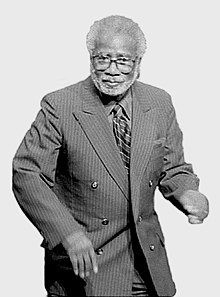LaVaughn Robinson
| LaVaughn Robinson | |
|---|---|

LaVaughn Robinson (1998)
|
|
| Born |
February 9, 1927 Philadelphia, USA |
| Died | January 22, 2008 (aged 80) Philadelphia, USA |
| Occupation | Tap Dancer, Choreographer, Teacher |
| Spouse(s) | Edna Martin Robinson |
LaVaughn Robinson (LaVaughn Evett) (February 9, 1927 – January 22, 2008) was an US tap dancer, choreographer, and teacher.
A virtuoso tap dancer, Robinson perfected a high speed, low to the ground, a cappella style of dance that was characterized by elegance, precision, and clarity of sound. In a career spanning over 70 years, he started performing on the street, then in nightclubs, and finally in national and international tap festivals. He was recognized by the National Endowment of the Arts as a "Living National Treasure", received a NEA National Heritage Fellowship in 1989, a lifetime honor, and a 1992 Pew Fellowship in the Arts.
LaVaughn Robinson was born in South Philadelphia, one of seven brothers and seven sisters. His mother (Catherine Griffin Robinson) taught him his first tap dancing step, the plain time step, at the age of seven. During the Depression, Philadelphia was a Mecca of tap dancing; the Nicholas Brothers (Fayard and Harold) and the Condos Brothers (Steve, Frank, and Nick) came from Robinson's neighborhood. Robinson learned from older street dancers, who vied for the best corners for busking. The elements of successful busking consisted of the ability to catch the attention of passersby, build a crowd, and then pass the hat. The competition required fierce demonstration of dancing prowess, like a gunfighter riding into town and challenging the local champion, with the winners getting better corners. The ultimate corner in Philadelphia was at Broad and South Streets. The better the dance ability, the nearer to Broad Street the dancer would be permitted busk. Broad Street being the same as 14th Street, the corners at either 2nd and South or 25th and South implied modest dance skills. Although he had no formal dance training, this competitive zeal influenced Robinson's style, and Broad and South became his corner at the age of 13. He also danced and played in a tramp band (washboard, washtub bass, and kazoo), and when he was older, he busked in clubs. Robinson earned enough money by busking to buy his own clothes, contribute to paying for the family groceries, and to go to the Earle Theater. It was here that Robinson saw the great tap dancers of the day: Baby Lawrence who performed with Count Basie Orchestra, the Nicholas Brothers with Dolly Dawn and the Dawn Patrol, and Robinson's particular favorite Teddy Hale with Louis Jordan. Robinson admired Teddy Hale's rendition of "Begin the Beguine", and particularly liked Hale's improvisational style, in which on successive performances, he performed entirely different dances, as opposed to a fixed act—the norm at the time. At this formative age, Robinson met Henry Meadows, an older dancer who took an interest in Robinson, and taught him a close to the ground, fast step called a paddle and roll, which was to be an important element in Robinson's mature style. Henry Meadows partnered with Robinson, on and off, over a period of 40 years.
...
Wikipedia
